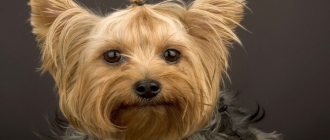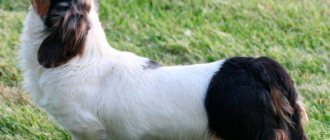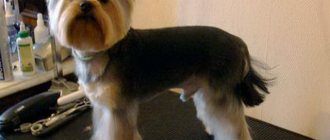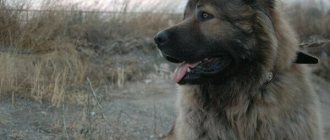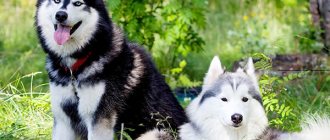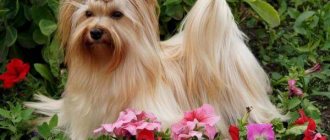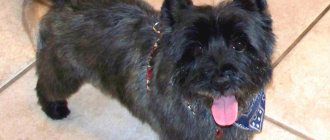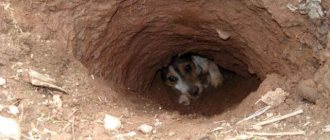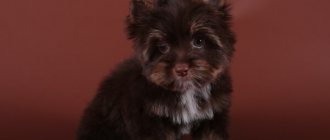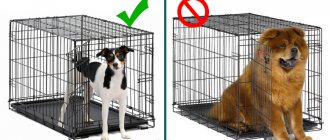The Yorkshire Terrier is one of the most popular and recognizable dog breeds in the world.
But not everyone knows that, in addition to the standard Yorkies, many more varieties of this breed have been bred, differing from each other in size and color.
And not all future owners of Yorkshire dogs with a standard color think about what a Yorkshire terrier puppy should look like and how its external differences from adult dogs are expressed.
What should a purebred Yorkie of any variety, gender or age look like?
Origin story
The Yorkie was not always a lap dog. At the dawn of the breed's history, these dogs, bred in Yorkshire, were working terriers: they destroyed rodents in houses and in mines.
Only later did they become a salon breed, and their popularization was greatly facilitated by the fact that Yorkshires were the favorites of Queen Victoria, during whose reign the breed was officially recognized.
At the beginning of the 20th century, the number of Yorkies was still small, but it was from this time that their spread throughout the world began..
The 1940s did not have the best effect on the breed, since during the Second World War people had no time for breeding dogs that had no practical value for the front.
But after its end, the number of Yorkies began to increase again, and the popularity of the breed began to revive.
By now, Yorkshire dogs are loved in many countries, including Russia . We can say that this is one of the most famous small dog breeds in the modern world.
Breed standard
According to the breed standard, the height of a standard Yorkie should not exceed 22 cm at the withers, and its weight should not exceed 3.1 kg..
The head is relatively small when compared to its size with the body. The skull is not convex, but rather flattened, the transition to the muzzle is pronounced, but not too sharp.
The dog's muzzle is short. The lips are tight-fitting and black. The chewing muscles are not very well expressed.
The teeth are even and small, there should be no gaps or, especially, gaps between them . Only a scissor bite is allowed. The nose is small and has black pigmentation.
The eyes are medium-sized, set approximately at an average level, not too protruding. The pigmentation of the eyes is brown, the darker the shade, the better. The expression of the eyes is intelligent, alert, lively.
The ears are triangle-shaped, erect, set approximately at the height of the forehead, and not widely spaced. The ear cartilage is quite thin, but elastic. The outside of the ears is covered with short hair of a rich brownish-red hue.
The body is compact, rectangular in format, without looking stretched.
The neck is of medium length and graceful lines.
The withers are weakly defined, the chest is oval in shape, not very deep or wide. The back is short, strong, and not sagging. The abdominal line is moderately tucked.
Limbs are straight and even . Elbows and hocks are parallel, but not too pronounced. Paws are collected, round in shape. The claws are black, moderately curved.
The dog usually holds its tail no higher than the spine, and only when running it is thrown over its back in the form of a plume.
The coat is very long, flowing, completely devoid of undercoat, making its texture similar to human hair.
The standard states that Yorkies' hair should be of medium length; in fact, show dogs have hair so long that it reaches the floor. The photo below shows groomed pets in clothes.
NOTE!
The color of the standard Yorkie is based on the contrast of brownish-red and steel-gray shades, slightly diluted with golden ash on the chest and paws.
In this case, the head, including the ears, is rich red, and from the occipital protuberance and below the color should be gray.
The main difficulty in breeding show Yorkies is obtaining dogs with the most saturated steel-gray coat color .
Selecting the size
For standard Yorkies, size S is suitable, and for mini and micro varieties - XS. For large Yorkies, clothing in size M may also be suitable.
It should be taken into account that the main measurements in these sizes are:
- XS: Neck girth - 18 - 22 cm, back length - 18 - 22 cm, chest girth - 28 - 32 cm.
- S: neck girth - 20 - 24 cm, back length - 22 - 26 cm, chest girth - 36 - 40 cm.
- M: neck girth - 24 - 28 cm, back length - 27 - 31 cm, chest girth - 40 - 44 cm.
Depending on the breed variety and height, shoes of sizes 1 - 3 are suitable for Yorkies.
Briefly about character and temperament
Yorkshires are distinguished by their courage, balance and always good spirits. These dogs are affectionate and loving: they simply adore their owners and are ready to do anything to please them.
Yorkies are smart and quick-witted: they are willing to learn and train.
If it were not for their small size and fragility of build, it would be difficult to find a more suitable breed for sports, for example, agility: after all, Yorkshires are hardy and passionate, like all terriers.
It is the latter circumstance that makes them the “stars” of numerous shows and exhibitions: the Yorkie loves and knows how to show himself in the best light.
These dogs, if raised correctly, do not cause problems: they get along well with other pets and with children, but if necessary, they can also turn out to be good guards.
They also love to accompany their owners everywhere - from going to the store to traveling around the world.
The affectionateness of Yorkies also has the other side of the coin: these dogs are very dependent on their owners and do not tolerate loneliness very well..
Read more about the character of Yorkies here.
Character
Yorkshire terriers are not similar in character to many decorative dogs. They are very energetic, stubborn and persistent.
This breed often strives for independence; sometimes Yorkies can even dominate their owner and take on the role of leader. They can hunt smaller animals - rats and mice. Yorkies will also persistently defend their territory.
But still, Yorkies are very affectionate and will treat family members with tenderness. However, the Yorkie will most likely become strongly attached to only one owner and will follow him like a shadow. In addition, they have high intelligence, which contributes to good training.
The Yorkshire Terrier is not the best choice if you have small children. In this case, it is worth looking for a more “family” dog: patient, phlegmatic, with a stronger constitution
Popular types of Yorkshire terriers and their descriptions
To date, three types of York have been bred, differing in size.:
- Standard: from 2.6 to 3.1 kg.
- Mini: from 1.5 to 2.5 kg.
- Super-mini or micro: from 1 to 1.5 kg.
All three species have the same body structure, as well as character and temperament.
The following color variations of the Yorkshire Terrier are also now known:
- standard;
- beaver;
- biro;
- goldust;
- choco;
- white;
- black.
Of all these varieties, only beavers have received official recognition. All other color variations, except for them and the standard, are considered a defect in the breed and are not allowed for exhibitions.
Baby-face Yorkies , which have a non-standard head structure and a shortened muzzle, are especially popular in the modern world .
Outwardly, these dogs look like a soft toy and can be not only standard, but also mini or micro. And the baby-face color can be any of the ones listed above.
Pets that are a cross between a toy terrier and a Yorkshire dog also look especially special . Read about this cross here.
Health
Characteristic diseases
Small dogs need to have their temperature taken and examined daily. Then you can notice signs of the disease in time. Yorkies are prone to the following diseases:
- allergy;
- paw dislocations and fractures;
- problems with the kidneys, pancreas and liver caused by dietary errors;
- dermatitis;
- diseases of the teeth, eyes and ears;
- heart disease;
- hernias
But with good care they can be avoided or minimized.
This gentle breed is a Yorkshire Terrier dog; it requires constant care. Bathe weekly with shampoo and conditioner and blow dry. Comb every day using balms, sprays, lotions
Vaccinations
The first vaccination is at 8 weeks. Repeat in two weeks. The next one at 3.5 months, at 5 and 6 months.
Then every year, trying to get into the same period. Deworm the terrier in at least 1.5 weeks.
For 2 weeks after vaccination, you should not bathe, overcool or walk - the body must develop immunity.
Main types of colors
Beaver
It has a bright, white-black-red color and a black nose, while the proportional ratio of colors can be any: along with beavers, which have a white color with small spots, there are also individuals whose main color could be called, rather, black.
However, it is the light-colored dogs that are most popular..
Biro
It is colored white-brown-red, the location of the spots and their size may vary.
There are also almost brown biros that have a slight tan and small white markings (shown in the photo).
The nose of Biro Yorkies is brown in various shades.
Goldust
The main color of the coat is golden-fawn of various tones.
May be supplemented with small white markings.
Chocolate or choco
Its color can be any of the brown tones: from light brownish to dark chocolate.
There may be some small white markings and tan, but its color is not the deep red of the Biro, but rather a pale brown.
Black
The color of his coat should be intense black.
Small white markings are acceptable, such as a white “tie” or “socks”, as well as a narrow blaze on the forehead.
White
Such dogs are very rare (shown in the photo).
Ideally should be snow white.
The eyelids, nose and edges of the lips are only allowed to be black, and the eyes should be as dark a brown shade as possible.
What do boys and girls look like and how do they differ?
Like other breeds, Yorkie boys look very impressive and impressive, while girls look more graceful and gentle, and are a pleasure to look at!
Also, their head may visually look somewhat smaller in proportion than that of males.
If in other breeds of dogs boys are usually larger, then in Yorkies this is ambiguous: even among individuals of standard size, a female can be larger than a male, which sometimes creates difficulties in breeding these dogs.
What do the puppies look like?
The color of a newborn Yorkie puppy is black and tan, like a Rottweiler, and the fur is about the same length (as the puppies in the photo).
But as they grow older, the color of the coat begins to change, and its length gradually increases.
A small Yorkie begins to bloom from the head, the color of which changes from black to golden-red, and an adult Yorkie should have no black hairs left on the head at all.
The color on the chest and paws changes in approximately the same way and, as a result, the fur there acquires a golden-ashy hue.
The steel color begins to appear first from above: on the neck, back and rump.
At the same time, the hair itself lightens unevenly: a grayish tint appears first at its base and only then drops lower, towards the tip.
IMPORTANT!
The color is finally formed by the age of two or three, and it is not always the desired color.
Many Yorkies grow noticeably lighter in color, and in some of them the areas of contrasting colors do not have clear outlines.
With age, the texture of the Yorkie's coat also changes: from short and smooth at birth, by the time the pet is one year old, it becomes thinner, longer and silkier, as in the picture below.
How to choose a pet?
This is not too difficult if we are talking about a pet: it is only enough that the puppy is healthy, liked by the owner and more or less meets the standard.
When a future champion is bought, then everything is much more complicated.
The main problem when choosing a standard-colored Yorkie puppy is that what its final color will turn out to be can only be guessed at..
As a rule, if the litter is well-grown and the puppies have good heredity, then they look almost the same, apart from some differences in size.
And even if the puppies differ in the intensity of their tan, this does not mean anything about their future adult color.
In this case, you can focus on what color the parents of the selected puppy have. Also, if this is not the first litter born from them, then it would be nice to look at the already adult brothers and sisters of the future pet.
If exterior characteristics are of paramount importance for the future owner, then experts recommend buying not a puppy, but a young dog after coloring, which may have already won the first of its show victories.
Of course, buying a promising adult dog is not a cheap pleasure.
But such a step ensures that the Yorkie meets the requirements of the standard and that no unpleasant surprises in the form of too light or unclear color are expected.
The Yorkshire Terrier is an amazing breed. He has a silky and smooth coat, completely devoid of undercoat, which no other dog in the world has.
Born completely smooth and black and tan, the Yorkie changes color to a contrasting fawn-steel with age, and its coat grows to the ground.
However, it is precisely because of this feature, called overcoloring, that it is very difficult to predict what the color of an adult dog will be. But, regardless of size and coat color, these dogs are loved and recognized all over the world.
Rules for choosing clothes: not only comfortable, but also safe
Terriers have a proportional build, so choosing clothes for Yorkies will not be difficult even without trying them on.
Representatives of terriers include such breeds as Bedlington, Sealyham Terrier, Cairn Terrier, Black Russian Terrier, Jack Russell Terrier, Boston Terrier, Kerry Blue Terrier, Parson Russell Terrier, Welsh Terrier, and Staffordshire Terrier.
But when choosing, you should definitely pay attention to the material from which the model you like is made.
Quality of fabric and tailoring
For long-haired pets, a silk-lined or polished cotton robe is a good option. Such fabrics do not inhibit heat transfer and help prevent wool tangling.
The material from which clothes and accessories are made must be non-toxic, since dogs can chew anything when they are bored.
Right size
Clothes for dogs are chosen in the same way as for people - first they take measurements and determine the size.
To begin, use a flexible measuring tape to measure the length of the back (from the beginning of the neck to the beginning of the tail) and the girth of the chest (behind the front legs).
Important! Clothes must fit perfectly. Outfits that are too loose or too tight can cause injury.
When taking measurements, the dog should stand up straight and head should be raised. After the measurements are taken, you need to add 3-5 cm to the obtained parameters.
The size of your Yorkie can be determined from the table:
| Size | Back, cm | Chest, cm | Neck, cm | Weight, kg |
| XS | 17-21 | 24-28 | 17-20 | 1 |
| S | 21-25 | 28-34 | 20-23 | 1-2 |
| M | 25-29 | 35-39 | 25-27 | 2-4 |
Convenience and functionality
In order for your pet to feel comfortable in clothes, they must meet the following requirements:
- All seams must be external. If the seams are internal, then the dog’s hair will fall off, calluses will appear and irritation will appear.
- Fastenings must be correct (snaps, hooks or buttons). Velcro and zippers are completely unsuitable for long-haired breeds.
- Clothing must fully perform its function. All decorations should be positioned so as not to interfere with the dog or injure him.
